
Alfa Romeo BAT
Encyclopedia
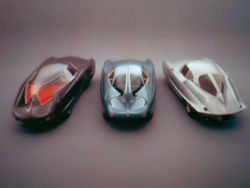
Concept car
A concept vehicle or show vehicle is a car made to showcase new styling and or new technology. They are often shown at motor shows to gauge customer reaction to new and radical designs which may or may not have a chance of being produced....
. The car originated in a joint collaboration project between Alfa Romeo
Alfa Romeo
Alfa Romeo Automobiles S.p.A. is an Italian manufacturer of cars. Founded as A.L.F.A. on June 24, 1910, in Milan, the company has been involved in car racing since 1911, and has a reputation for building expensive sports cars...
and the Italian design house; Bertone that began in 1953. Of the successful project came three cars: the BAT 5 in 1953, the BAT 7 in 1954, and finally the BAT 9 in 1955.
History
Alfa Romeo contacted Giuseppe "Nuccio" Bertone of the Bertone design house in order to commission three concept vehicles with extensive research on the effects of drag on a vehicle. The idea was to create vehicles with the lowest possible drag coefficientDrag coefficient
In fluid dynamics, the drag coefficient is a dimensionless quantity that is used to quantify the drag or resistance of an object in a fluid environment such as air or water. It is used in the drag equation, where a lower drag coefficient indicates the object will have less aerodynamic or...
. The cars were named BAT for "Berlinetta
Berlinetta
Berlinetta is an especially sporty form of coupé. Typically a two-seater, the type may include 2+2s.The real meaning for berlinetta in Italian is "little saloon".Introduced in the 1930s, the term was popularized by Ferrari in the 1950s...
Aerodinamica Tecnica." All the cars featured large rear bumpers and curved fins, truly a unique design. They were built upon the Alfa Romeo 1900
Alfa Romeo 1900
The Alfa Romeo 1900 is a sports sedan designed by Orazio Satta for the Alfa Romeo company in 1950. It was Alfa Romeo's first car built entirely on a production line and was also Alfa's first production car without separate chassis and first Alfa offered with left-hand drive...
chassis. Each year between 1953 and 1955 at the Turin
Turin
Turin is a city and major business and cultural centre in northern Italy, capital of the Piedmont region, located mainly on the left bank of the Po River and surrounded by the Alpine arch. The population of the city proper is 909,193 while the population of the urban area is estimated by Eurostat...
Auto show
Auto show
An auto show, or motor show, is a public exhibition of current automobile models, debuts, concept cars, or out-of-production classics. It is commonly attended by automobile manufacturers. Most auto shows occur once or twice a year...
, Bertone and Alfa Romeo presented a BAT concept, the BAT 5, 7 and 9.
The cars were successful in their goal, the best achieving a drag coefficient
Drag coefficient
In fluid dynamics, the drag coefficient is a dimensionless quantity that is used to quantify the drag or resistance of an object in a fluid environment such as air or water. It is used in the drag equation, where a lower drag coefficient indicates the object will have less aerodynamic or...
of 0.19, an achievement even by today's standards. For each of the cars, Alfa Romeo provided a five-speed gearbox and a powerful four-cylinder engine that produced more than 90 hp, good enough to propel the car to a top speed of 125 mph (201.2 km/h). The three original BATs are currently on exhibit at the Blackhawk Museum in Blackhawk, California.
BAT 5
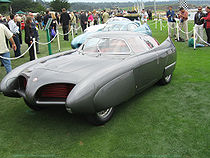
BAT 7
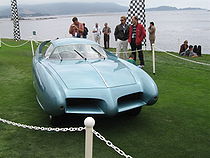
The nose was lower than the BAT 5's, and the protrusions where the headlights would normally be found stuck out even further. The headlights were located next to the nose and moved to point down when used. Even Fiat's experimental one-off wind-tunnel-derived Turbine car, the Turbina
Fiat Turbina
Fiat Turbina was a 1954 concept car built by Italian manufacturer Fiat. It was unusual in using a gas turbine for propulsion.In 1954 Fiat was the second car manufacturer, after Rover, to introduce a car propelled by a gas turbine. The project took a long period of planning, studies began in 1948...
, which also made its debut at the show, seemed tame in comparison. The Cd was 0.19.
The BAT 7 features in the Top Gear book Daft Cars by Matt Master
BAT 9
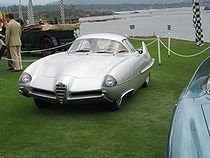
The BAT 9 did away with the marked wing lines of the previous models in favour of a cleaner, more sober line. The tail fins, which in the other two models, 5 and 7, had a real wing-like look, were sized down into two small metal plates, much like the tail fins in production on American and some European cars of the time. Bertone transformed the highly creative styling of the two previous BAT models into design credibility, abandoning the extremes of the other designs.
BAT 11
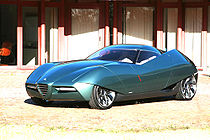
Geneva
Geneva In the national languages of Switzerland the city is known as Genf , Ginevra and Genevra is the second-most-populous city in Switzerland and is the most populous city of Romandie, the French-speaking part of Switzerland...
, at the time of the 2008 Geneva Auto Show, though not at the show itself. The new BAT 11, based on the Alfa Romeo 8C Competizione
Alfa Romeo 8C Competizione
The Alfa Romeo 8C Competizione is a sports car produced by Italian automaker Alfa Romeo. It was first presented as a concept car at the 2003 Frankfurt Motor Show and later released for sale for the 2007 model year...
, shares many styling cues with the classic BAT cars of the 50s.

